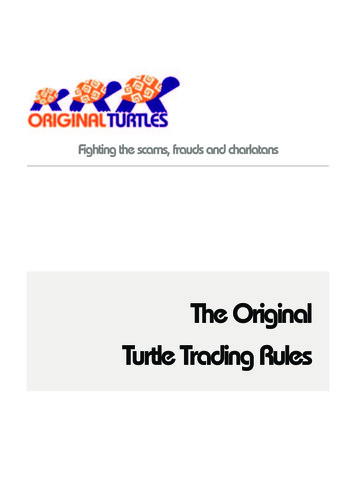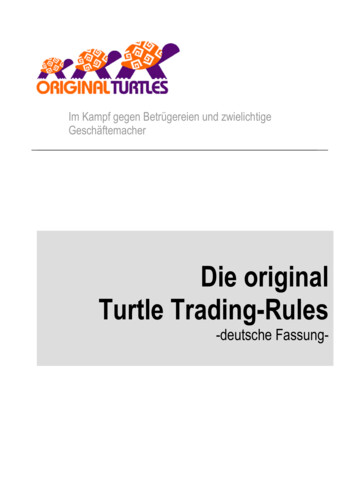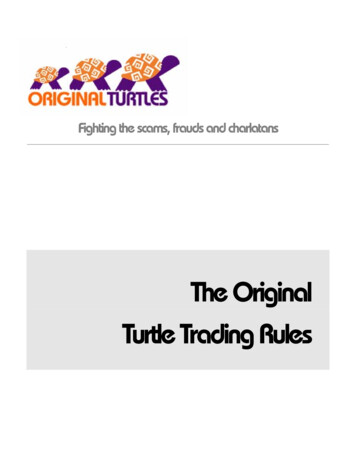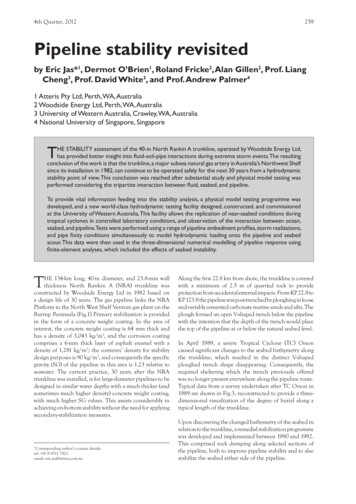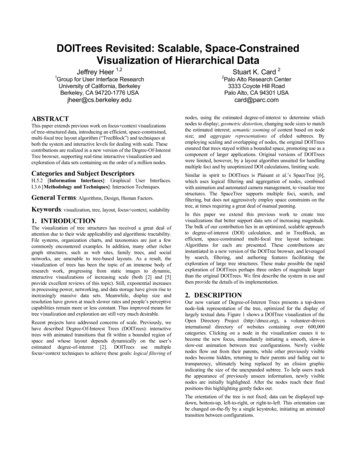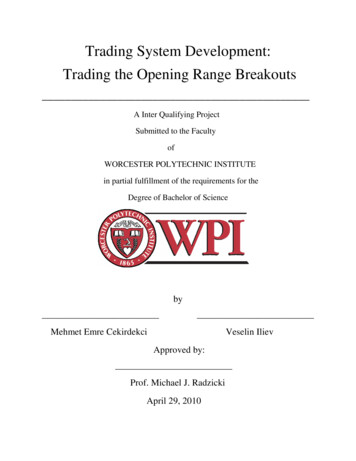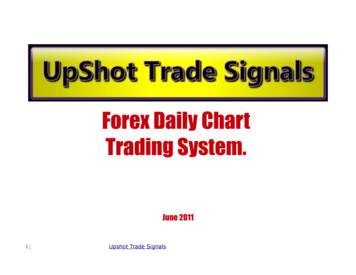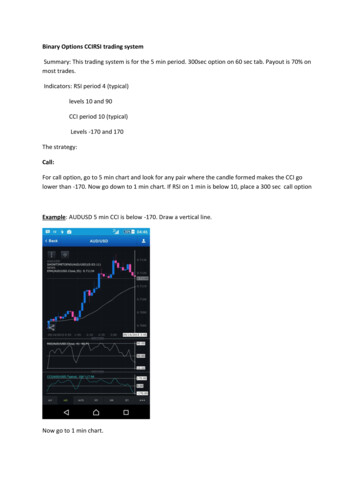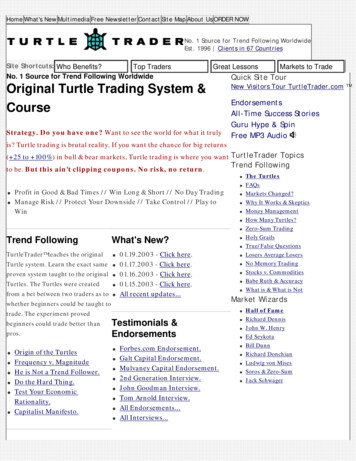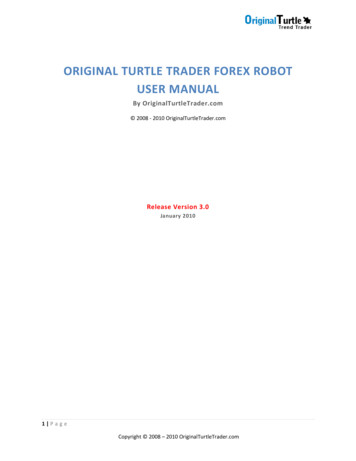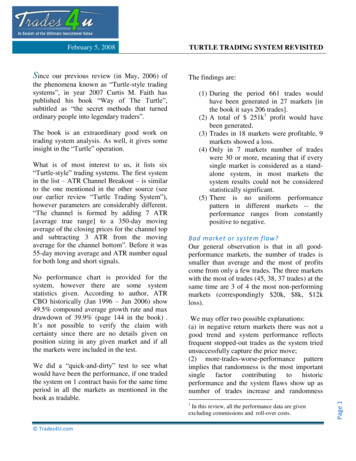
Transcription
Sinceour previous review (in May, 2006) ofthe phenomena known as “Turtle-style tradingsystems”, in year 2007 Curtis M. Faith haspublished his book “Way of The Turtle”,subtitled as “the secret methods that turnedordinary people into legendary traders”.TURTLE TRADING SYSTEM REVISITEDThe findings are:(1) During the period 661 trades wouldhave been generated in 27 markets [inthe book it says 206 trades].(2) A total of 251k1 profit would havebeen generated.(3) Trades in 18 markets were profitable, 9markets showed a loss.(4) Only in 7 markets number of tradeswere 30 or more, meaning that if everysingle market is considered as a standalone system, in most markets thesystem results could not be consideredstatistically significant.(5) There is no uniform performancepattern in different markets -- theperformance ranges from constantlypositive to negative.The book is an extraordinary good work ontrading system analysis. As well, it gives someinsight in the “Turtle” operation.What is of most interest to us, it lists six“Turtle-style” trading systems. The first systemin the list – ATR Channel Breakout – is similarto the one mentioned in the other source (seeour earlier review “Turtle Trading System”),however parameters are considerably different.“The channel is formed by adding 7 ATR[average true range] to a 350-day movingaverage of the closing prices for the channel topand subtracting 3 ATR from the movingaverage for the channel bottom”. Before it was55-day moving average and ATR number equalfor both long and short signals.No performance chart is provided for thesystem, however there are some systemstatistics given. According to author, ATRCBO historically (Jan 1996 – Jun 2006) show49.5% compound average growth rate and maxdrawdown of 39.9% (page 144 in the book) .It’s not possible to verify the claim withcertainty since there are no details given onposition sizing in any given market and if allthe markets were included in the test.We did a “quick-and-dirty” test to see whatwould have been the performance, if one tradedthe system on 1 contract basis for the same timeperiod in all the markets as mentioned in thebook as tradable.Bad market or system flaw?Our general observation is that in all goodperformance markets, the number of trades issmaller than average and the most of profitscome from only a few trades. The three marketswith the most of trades (45, 38, 37 trades) at thesame time are 3 of 4 the most non-performingmarkets (correspondingly 20k, 8k, 12kloss).We may offer two possible explanations:(a) in negative return markets there was not agood trend and system performance reflectsfrequent stopped-out trades as the system triedunsuccessfully capture the price move;(2) more-trades-worse-performance patternimplies that randomness is the most importantsingle factor contributing to historicperformance and the system flaws show up asnumber of trades increase and randomness1In this review, all the performance data are givenexcluding commissions and roll-over costs. Trades4U.comPage 1February 5, 2008
factor gets smoothed out.In our opinion, there is no sufficient data to tellwhich explanation better reflects reality.Long holding periodOn June 30, 2006 the system model showsseveral open trades with huge profits, actuallyin several markets such one open trade hasprofits exceeding total system performance (i.e.covers losses from previous trades).Some of the most extreme examples are:MarketProfit perTradecontractinception( ’000)(dd.mm.yyyy)Copper6514/05/2003Heating Oil5104/10/2003Crude URTLE TRADING SYSTEM REVISITEDwould be required and such account size islikely to be sufficient for trading the strategywithout a major account wipe-out risk.However, 48.5% “compound rate” equals about7% “non-compound” rate, i.e. initial accountsize of more than 400k with about 25kannual profits.What is performance after the sampleperiod?If one traded the system from July 2006 toDecember 2007 with 1 contract in everymarket, the total profit would be 22k.Combined exchange rate margin for all the 27contracts is about 90k as at the date of writing.An account size at 4 times the exchange marginimplies a 360k trading account for the tradingstrategy. So, out-of-the-sample period shows astable, the same as historic, “non-compound”performance rate of 7%.There was a long gold trade open since March,2001 (5 years and 3 months) and long coppertrade open since May, 2003 (3 years and 1month). If you look at the price chart of gold orcopper, then it can be seen that the system hascaptured a fantastic long-term move and,retrospectively correctly, remaining with thetrade even through 20-25% draw-downs).However, there is something extraordinary –during this 18 month period, natural gas tradeshave lost 82k - more than the sum of lossesfrom other 14 losing markets. Apparently, thesystem is out of sync with market and unable tocapture the short, sharp trends characteristic tonatural gas market during this period.Performance data verificationIs 49.5% performance and 39.9% maxdrawdown claim correct? It could be. However,the term “compound average growth rate” canbe a misleading since it is not clear if the mostof performance took place at the beginning orthe end of the sample period or if it was smoothover the whole time mance figure mentioned in the bookcould be correct, however in a morestraightforward, “non-compound” terms, it islikely to be 7% annual return. 7% return with40% drawdown doesn’t make exactly greattrading system.In our opinion, the performance data claimcould be correct since our findings suggest thatto achieve the performance, an initial accountequal to about 4-5 times exchange marginsThere is a considerable risk that the system getsout of sync with one or more markets and suchsituation may result in disproportionate lossesas illustrated by natural gas trades in 18 month Trades4U.comPage 2February 5, 2008
February 5, 2008TURTLE TRADING SYSTEM REVISITEDperiod to December 2007.Does the trading system represent a goodinvestment value if applied in real-time tradingaccount? Hardly in its raw form - performanceis limited and there are inherent critical risks.However, it definitely contains some elementsof trading system what may perform well incertain market conditions and/or if critical risksare addressed. Update on February 25, 2008All the tests were done on 30 year data (or anyshorter periods for which data is available forany particular contract) with Feb 25, 2008 asend date.If you are interested in historic performancedata for any particular market or system codefor any particular trading strategy, please sendan inquiry for this information toinfo@trades4u.com.However, our general conclusion is that noneof the systems considered represent anyinvestment value.Page 3We tested the other 4 systems mentioned thebook and the findings are: Bollinger Breakout: doesn’t work,generally equity fluctuates around zero; Donchian Trend: performs relativelywell in currency markets only, howeverreturns generally are in 2% area withdrawdowns of 10-15%. Donchian Trend with Time Exit: thesame as for Donchian trend, except forcrude oil market (18% annual returnwith less than 10% drawdown duringY2004-2007 period). Dual Moving Average: performsrelatively well in currency markets,however returns are in 1-3% p.a. areawith drawdowns of 25% and above. Forexample, the most profitable market in the sample was EUR with 3 % returnand 24% drawdown.Triple Moving Average: we didn’t finda single reasonably profitable market.Only in 4 out of 27 markets the strategyshowed marginally positive returns, inall cases below 2% p.a. Trades4U.com
February 5, 2008TURTLE TRADING SYSTEM REVISITEDThe tables below summarize performance of the trading system in various markets both in in-thesample period (January 1996 to June 2006) and out-of-sample period (July 2006 to December 2007).Jan'96 - Jun'06Jul'06 - Dec'07MarketTrades Profit ( '000)Australian dollarBritish poundCornCocoaCanadian dollarCrude OilCottonEuroEurodollarFeeder cattleGoldCopperHeating oilUnleaded gasolineJapanese yenCoffeeCattleHogsMexican pesoNatural gasSoybeansSugarSwiss francSilver5yr Treasury Notes1oy Treasury Notes30yr Treasury 210825-821-26-20-12MarketProfit ( '000)Australian dollar13British pound16Corn5Cocoa-8Canadian dollar10Crude Oil19Cotton-5Euro18Eurodollar-2Feeder cattle-8Gold24Copper-20Heating oil7Unleaded gasoline-14Japanese yen14Coffee-10Cattle-3Hogs1Mexican peso-9Natural gas-82Soybeans32Sugar-3Swiss franc2Silver145yr Treasury Notes-21oy Treasury Notes-730yr Treasury Bonds-6Wheat26Total:661251Total:Page 422 Trades4U.com
February 5, 2008TURTLE TRADING SYSTEM REVISITEDThe “beauty contest” of the markets as implied by the backtested, historic performance.The “beautiful” (euro to June 2006) .Page 5 and the “ugly” (natural gas January 1999 – December 2007) Trades4U.com
trading system analysis. As well, it gives some insight in the “Turtle” operation. What is of most interest to us, it lists six “Turtle-style” trading systems. The first system in the list – ATR Channel Breakout – is similar to the one mentioned in the other source (see our earlier review “Turtle Trading System”),
